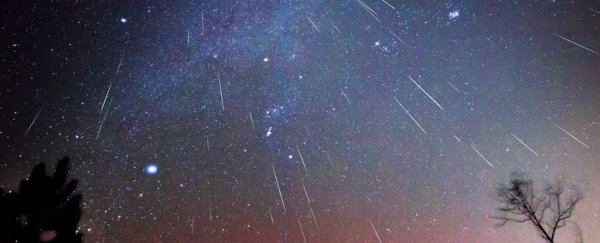The Geminids meteor shower peaks on the mornings of December 13 and 14, 2018 – but if you look up any time there's a clear night sky up until December 17, you might just catch a glimpse of a Geminid meteor.
The Geminids shower is unusual as it is one of two meteor showers confirmed to be caused by an asteroid (most meteor showers are caused by comets).
The Earth passes through the debris cloud scattered by an asteroid called 3200 Phaethon in December each year. The fiery display is caused as the debris is vapourised by Earth's atmosphere, having travelled through the solar system for 4.6 billion years.
The Geminids shower is noted for producing 120 or more meteors per hour, which travel at around 35 kilometres per second (22 miles per second), and are often brightly coloured.
The colours indicate the main chemical composition of that particular meteor. An orange or yellow colour denotes sodium, yellow signifies iron, blue-green means magnesium and violet indicates calcium.
If the meteor appears red, that's nitrogen and oxygen atoms in the atmosphere glowing as they are super heated by the space dust slamming into them at high speed.
About that asteroid
3200 Phaethon has a wildly eccentric orbit, quite different to many other asteroids. At its furthest point from the centre of the solar system, 3200 Phaethon enters the asteroid belt between the orbits of Mars and Jupiter, around 360 million kilometres (224 million miles) from the Sun (for context, Earth is around 150 million kilometres (93 million miles) from the Sun).
At its closest point, it's 21 million kilometres (13 million miles) away – a mere stone's throw from the Sun, in astronomical terms.
Here, the asteroid can bake in temperatures up to 750 degrees Celsius (1,382 Fahrenheit).
3200 Phaethon is a measly 5.8 kilometres (3.6 miles) long. It crosses the orbit of the Earth, so it's classed as a near Earth object (NEO). But it's unlikely to ever hit the Earth: the next nearest approach is not until 2093, at a distance almost eight times further away than the moon.
Beyond 2093, if it did hit us, it would cause significant damage, but it probably wouldn't cause an extinction-level event. The asteroid or comet that helped to wipe out the dinosaurs is estimated to have been 10 to 15 kilometres long (6 to 9 miles).
The extreme variations in temperature experienced by 3200 Phaethon, together with a very short day of just 3.6 hours and regular close encounters with the Sun causes the asteroid to shed dust and debris at a rate great enough that dust tails have been observed.
This, and other observations, have led some astronomers to describe this object as a comet or a "rock comet", somewhat blurring the line between asteroids and comets.
Indeed, scientists are only just beginning to understand the distinction between comets and asteroids. In the past, scientists thought of comets as interlopers from the far outskirts of the solar system, which were somehow disturbed and dragged inwards by the gravity of the Sun.
Asteroids, on the other hand, were thought to have formed alongside the planets, ending up on the boundary of the inner and outer solar system.
They mostly reside in the asteroid belt – altogether, their total mass is no more than around 4 percent of the moon.
While 3200 Phaethon is often referred to as an asteroid, it seems the more we learn, the less relevant the distinction between the terms asteroid and comet really is.
Technically, these terms are already obsolete, because in 2006, when the International Astronomical Union (IAU) reclassified Pluto as a dwarf planet, it also decided that "all other objects, except satellites, orbiting the Sun shall be referred to collectively as small solar-system bodies".
This essentially removes the need for words like asteroid and comet, but of course they persist in the scientific and public vocabulary.

Become a citizen scientist
Meteors are best observed in a dark location with a clear view of the sky – a backyard or local park, or even better, the countryside. It's worth staying for at least an hour, to increase your chances of spotting one.
Any time you are sky watching, if you happen to see a huge, bright meteor that lasts for several seconds – known as a fireball – you can report it to scientists so that they can follow up.
If the piece of rock that caused the fireball was large enough, some of it could make it to the ground, becoming a meteorite.
For every report that is submitted, the easier it will be to possibly find some left over space rock to study.
Make a note of the time you saw the fireball, the direction it travelled and any other relevant information. If you happen to capture a photo or a video, even better.
These reports are really valuable as they help scientists in various fields: it could help astronomers identify unknown NEOs, and help geologists and planetary scientists to learn more about the formation of our solar system. ![]()
Samantha Rolfe, Lecturer in Astrobiology and Principal Technical Officer at Bayfordbury Observatory, University of Hertfordshire.
This article is republished from The Conversation under a Creative Commons license. Read the original article.
